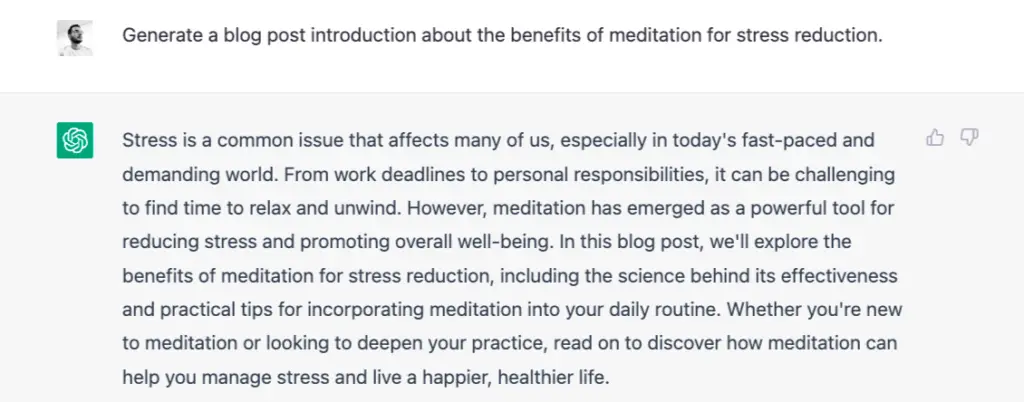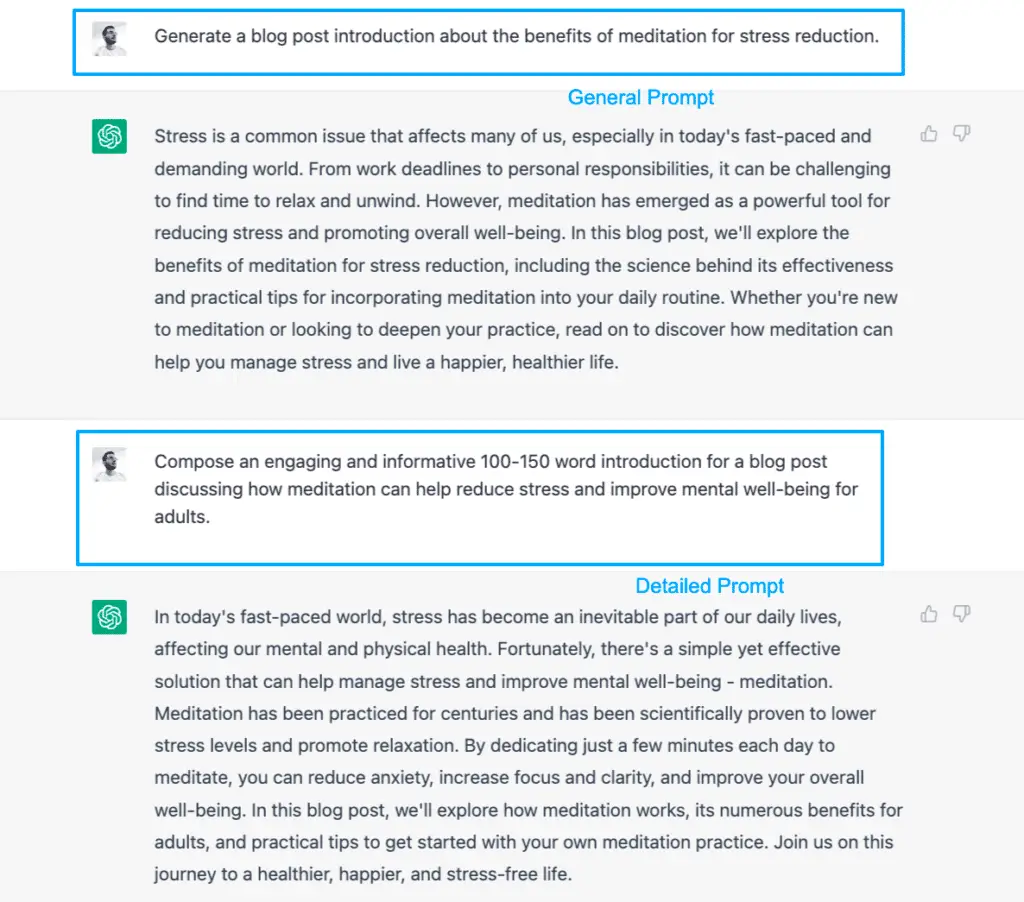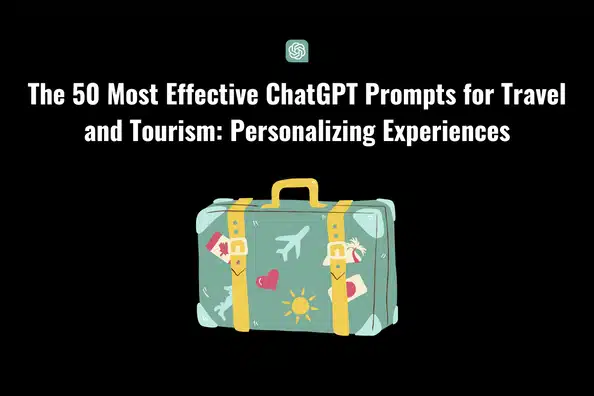ChatGPT, powered by OpenAI’s advanced language model, has taken the world by storm with its ability to generate human-like text. One of the keys to unlocking its full potential lies in the effective use of prompts.
This blog post, written by the GPTPromptsHub team, aims to provide tips and examples on how various industries and professionals can leverage ChatGPT to improve their work and efficiency. We’ll explore the benefits and best practices for creating prompts, and provide you with ten long-form examples for various use cases and subjects.
Tips for ChatGPT Prompts in Different Industries
Education: Teachers can use ChatGPT prompts to create lesson plans, design engaging activities, or generate thought-provoking discussion questions for students.
Healthcare: Medical professionals can utilize ChatGPT prompts to create patient education materials, draft case studies, or generate summaries of complex research articles.
Marketing: Marketers can leverage ChatGPT prompts to craft compelling ad copy, brainstorm content ideas, or generate engaging social media posts.
Finance: Financial analysts can employ ChatGPT prompts to summarize market trends, generate investment analysis reports, or create financial projections.
Software Development: Developers can use ChatGPT prompts to draft technical documentation, create code comments, or outline software features and functionalities.
Human Resources: HR professionals can leverage ChatGPT prompts to draft employee communications, create job descriptions, or generate training materials.
Sales: Salespeople can use ChatGPT prompts to create persuasive sales pitches, draft follow-up emails, or generate product descriptions and benefits.
Legal: Legal professionals can employ ChatGPT prompts to draft contracts, create legal briefs, or generate summaries of complex legal cases.
Benefits of Using ChatGPT Prompts in Various Professions
Improved efficiency and productivity: By automating tasks such as content creation or research summaries, professionals can save time and focus on other important aspects of their work.
Enhanced creativity and problem-solving: ChatGPT prompts can generate unique ideas and solutions, helping professionals think outside the box and approach challenges from different perspectives.
Better decision-making: With the ability to analyze large amounts of data and generate concise summaries, ChatGPT can provide valuable insights that support informed decision-making.
Streamlined communication: ChatGPT prompts can help create clear, concise, and engaging communications, improving collaboration and understanding among team members.
Best Practices for Using ChatGPT Prompts
- Be clear and specific: Define the desired outcome and provide enough context for the AI to understand the task.
- Experiment with prompt phrasing: If the initial response isn’t satisfactory, try rephrasing the prompt or adding more context.
- Set a word limit: If you require a specific length for the response, set a word limit to avoid excessively long or short answers.
- Use step-by-step instructions: Break down complex tasks into smaller steps to help guide the AI through the process.
- Iterate and refine: ChatGPT may not provide the perfect response on the first try. Use the AI’s output as a starting point and edit or re-prompt as needed.
How to Craft a Perfect ChatGPT Prompt: The Complete Guide with Example
Crafting the perfect ChatGPT prompt is essential to getting the desired output from the AI. The key to a successful prompt is clarity, context, and structure.
In this section, we will guide you through the entire process of creating an effective ChatGPT prompt, using an example to illustrate each step.
Example Goal: Generate a blog post introduction about the benefits of meditation for stress reduction.

Define Your Goal
Before crafting the prompt, identify the specific outcome you want from ChatGPT. Clearly defining your goal will help you create a focused prompt that yields the desired results.
Example: The goal for this prompt is to create a compelling and informative introduction to a blog post about the benefits of meditation for stress reduction.
Provide Context and Background
To help ChatGPT better understand your request, provide any relevant context or background information.
Example: “I am writing a blog post for a health and wellness website about the benefits of meditation for stress reduction. The target audience is adults who are interested in improving their mental well-being.”
Be Clear and Specific
A clear and specific prompt is more likely to yield satisfactory results. Ensure that your prompt is concise, unambiguous, and includes any necessary details.
Example: “Write a captivating and informative introduction for a blog post about the benefits of meditation for stress reduction, targeted at adults seeking to improve their mental well-being.”
Break Complex Tasks into Smaller Steps
If you’re asking ChatGPT to complete a complex task, break it down into smaller, more manageable steps.
Example: Since our example prompt is relatively simple, breaking it down into smaller steps isn’t necessary in this case.
Set a Word Limit or Structure
If you have specific length requirements for the AI’s output, set a word limit or specify the desired structure.
Example: “Write a captivating and informative introduction (approximately 100-150 words) for a blog post about the benefits of meditation for stress reduction, targeted at adults seeking to improve their mental well-being.”
Experiment and Iterate
Sometimes, the first response from ChatGPT may not be exactly what you’re looking for. Don’t be afraid to experiment with different prompt phrasings or provide additional context.
Example: If the initial response doesn’t meet your expectations, you could try rephrasing the prompt: “Compose an engaging and informative 100-150 word introduction for a blog post discussing how meditation can help reduce stress and improve mental well-being for adults.”

Review and Edit the Output
ChatGPT-generated content may require some editing or revisions to meet your specific needs. Use the AI’s output as a starting point and make any necessary changes.
Once ChatGPT generates the introduction, review it for clarity, accuracy, and relevance. Edit as needed to ensure it aligns with your content goals and target audience.
By following these steps and using the example provided, you can craft a perfect ChatGPT prompt that generates the desired output. Remember that prompt creation is an iterative process, so don’t hesitate to experiment and refine your prompts to get the best results from ChatGPT.
10 Long-form ChatGPT Prompts Examples For Various Use-Cases
For each industry, we have provided one example prompt, totalling ten long-form prompts:
- Education: “Design a comprehensive lesson plan for a high school biology class on the topic of cellular respiration, including objectives, materials needed, instructional methods, and assessment strategies.”
- Healthcare: “Create a detailed patient education brochure on the importance of regular exercise for individuals with type 2 diabetes, outlining the benefits, recommended activities, and safety precautions to consider.”
- Marketing: “Craft an engaging social media campaign for a new eco-friendly cleaning product, targeting environmentally conscious consumers and emphasizing the product’s unique features and benefits.”
- Finance: “Generate a comprehensive analysis of the current market trends in the renewable energy sector, including key players, recent developments, and potential investment opportunities.”
- Software Development: “Outline the process of developing a mobile app for managing personal finances, detailing the necessary features, user interface design, and potential challenges during development.”
- Human Resources: “Create a compelling job description for a sales manager position, highlighting key responsibilities, qualifications, and benefits that will attract top talent.”
- Sales: “Write a persuasive sales pitch for a cutting-edge home security system, emphasizing its innovative features, ease of use, and the peace of mind it offers to homeowners.”
- Legal: “Summarize a complex intellectual property case involving a patent dispute between two major technology companies, detailing the key arguments, relevant legal precedents, and potential outcomes.”
- Engineering: “Develop a proposal for a sustainable urban infrastructure project that incorporates green technologies and innovative design principles to address the challenges of rapid urbanization.”
- Journalism: “Write an in-depth investigative article on the impact of social media on mental health among teenagers, exploring current research findings, expert opinions, and potential solutions to mitigate negative effects.”
FAQs
How can I ensure that ChatGPT provides relevant and accurate information?
Make your prompts clear and specific, and provide sufficient context. If necessary, verify the information generated by ChatGPT with reliable sources.
Are there any ethical considerations when using ChatGPT for professional purposes?
Ensure that you respect data privacy and intellectual property rights when using ChatGPT. Do not use AI to create misleading or harmful content.
How can I improve the quality of ChatGPT-generated content?
Experiment with prompt phrasing, provide clear instructions and set word limits. Be prepared to iterate and refine the generated content.
Is it safe to use ChatGPT for sensitive or confidential information?
Avoid sharing sensitive or confidential information with ChatGPT, as the data you input may be used to improve the AI model.
ChatGPT prompts offer a wide range of applications across various industries and professions, helping to improve efficiency, creativity, and decision-making.
By using the tips and examples provided in this blog post, professionals can harness the power of ChatGPT to enhance their work and unlock its full potential.


